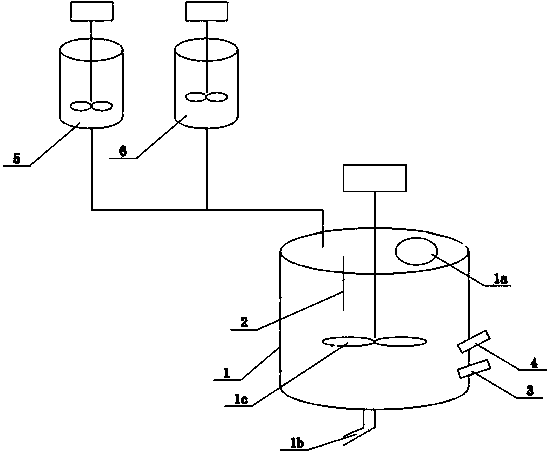Bioslurry repair method for poly brominated diphenyl ethers polluted soil, and special equipment
A polybrominated diphenyl ether and polluted soil technology, which is applied in the field of biological mud restoration of polybrominated diphenyl ether polluted soil, can solve problems such as weakened thyroid function, and achieve the effects of shortening the degradation time and improving the degradation effect.
- Summary
- Abstract
- Description
- Claims
- Application Information
AI Technical Summary
Problems solved by technology
Method used
Image
Examples
Embodiment 1
[0033] Step 1): In this example, a bioslurry reactor made of stainless steel with a volume of 50L and equipped with stirring and aeration devices was used for the test; the seed tank for cultivating fungi and bacteria was a 15L fermenter with stirring and aeration devices ; The fungi used in this example are 1 strain of Phanerochaete chrysosporium, and the bacteria are 1 strain of Sphingomonas; the Sphingomonas that will be cultivated in the LB liquid medium is inoculated with 2% inoculum Carry out expanded cultivation in the bacterial seed tank; Simultaneously the Phanerochaete chrysosporium cultivated in the potato liquid medium is inoculated into the fungal seed tank with the amount of 2%; In the present embodiment, dress 30L polybrominated diphenyl ether contaminated soil, water and soil in the biological reaction The ratio is 3:1. Add inorganic salt nutrients to the bio-slurry reactor to adjust the content of inorganic salts in the reactor: Na 2 HPO 4 12H 2 o 7 .7.036...
Embodiment 2
[0039] Embodiment 2: polybrominated diphenyl ether polluted soil and water are 2:1 with water-to-soil volume ratio, adjust the inorganic salt content in the reactor: Na 2 HPO 4 12H 2 O6g / L, KH 2 PO 4 0.8g / L, (NH 4 ) 2 SO 4 0.3g / L, MgCl 2 ·6H 2 O 0.08g / L, Ca(NO 3 ) 2 4H 2 O40mg / L; trace element content FeSO 4 ·7H 2 O 2g / L, ZnSO 4 ·7H 2 O 0.02g / L,H 3 BO 3 0.2g / L, CoCl 3 ·6H 2 O0.2g / L, NiCl 2 ·6H 2 O0.02g / L,Na 2 MoO 4 2H 2 O 0.02g / L; Inoculate fungi and bacteria with polybrominated diphenyl ether degradation ability while reacting, the inoculum size is 5%; At a temperature of 25 ° C, the ventilation rate is 0.002m 3 / s, other with embodiment 1.
Embodiment 3
[0040] Embodiment 3: polybrominated diphenyl ether polluted soil and water are 4:1 with water-to-soil volume ratio, the inorganic salt content in the adjustment reactor: Na 2 HPO 4 12H 2 O 8g / L, KH 2 PO 4 1.2g / L, (NH 4 ) 2 SO 4 0.8g / L, MgCl 2 ·6H 2 O 0.12g / L,
[0041] Ca(NO 3 ) 2 4H 2 O460mg / L; trace element content FeSO 4 ·7H 2 O 3g / L, ZnSO 4 ·7H 2 O 0.04g / L, H 3 BO 3 0.4g / L, CoCl 3 ·6H 2 O0.3g / L, NiCl 2 ·6H 2 O 0.03g / L,Na 2 MoO 4 2H 2 O 0.04g / L, the inoculum size is 15%; the temperature is 30°C, and the ventilation volume is 0.008m 3 / s condition, others are the same as embodiment 1.
[0042] The microorganisms capable of degrading PBDEs described in the present invention can be obtained by screening PBDE-contaminated soils, or obtaining known high-efficiency degrading strains from bacterial strain preservation centers and research institutions in various countries. The fungi and bacteria inoculated in the bioreactor are first amplified and cultured...
PUM
 Login to View More
Login to View More Abstract
Description
Claims
Application Information
 Login to View More
Login to View More - R&D
- Intellectual Property
- Life Sciences
- Materials
- Tech Scout
- Unparalleled Data Quality
- Higher Quality Content
- 60% Fewer Hallucinations
Browse by: Latest US Patents, China's latest patents, Technical Efficacy Thesaurus, Application Domain, Technology Topic, Popular Technical Reports.
© 2025 PatSnap. All rights reserved.Legal|Privacy policy|Modern Slavery Act Transparency Statement|Sitemap|About US| Contact US: help@patsnap.com



